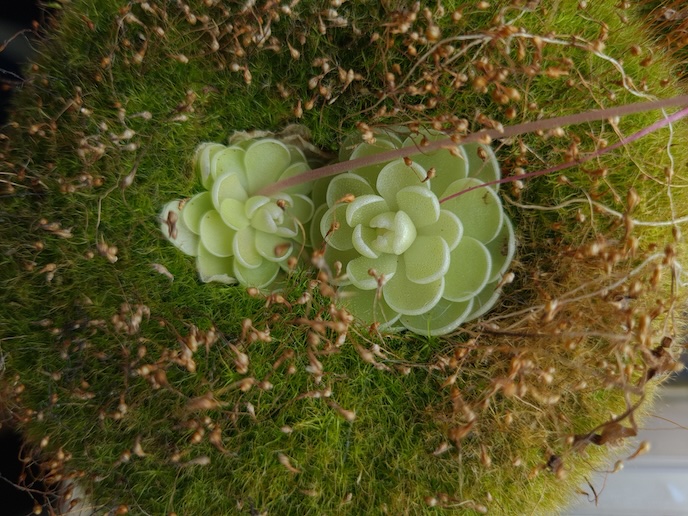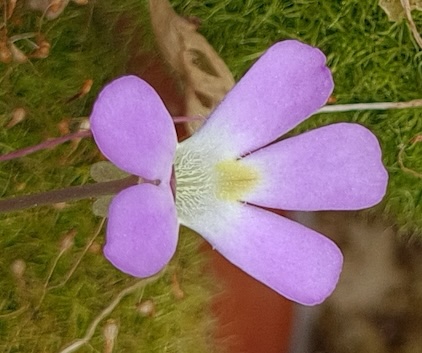

Pinguicula esseriana
General
Pinguicula esseriana is a charismatic species of butterwort, a group of carnivorous plants that thrive by supplementing their diets with small insects. Native to select regions in Mexico, this petite plant enchants with its rosette of sticky leaves and delicate blooms. Its compact form and ease of care make it a favorite among both experienced collectors and those dipping their toes into the world of carnivorous plants.
Physical Characteristics
This species is recognized for its tight, sculpted rosettes generally spanning only 2 to 4 centimeters across. Leaves are obovate to slightly spatulate, bright green, and boast a glossy, almost succulent appearance due to tiny mucilaginous glands. These glands both trap and digest unfortunate arthropod visitors. During flowering, slim stalks rise gracefully above the foliage to display small, violet to white blooms that add a touch of elegance to its demeanor.
Lifestyle
Like all butterworts, P. esseriana employs a passive trap system with its glistening leaves. Tiny insects are lured by the promise of moisture or nectar, only to become ensnared by sticky secretions. Digestive enzymes then aid in breaking down the prey, allowing the plant to extract vital nutrients. Although carnivory offers an advantage in nutrient-poor habitats, the plant still performs photosynthesis for the bulk of its energy needs.
Habitat and Protection
In the wild, this species inhabits limestone cliffs and rocky crevices, often shaded by overhanging vegetation. The native Mexican habitat features alternations between wet and dry seasons, to which P. esseriana is well adapted. Natural protection includes a dense wax coating on its leaves that helps prevent desiccation and provides some resistance against pests and pathogens.
Cultivation
Cultivating this butterwort in captivity is a delightful endeavor, especially for those interested in replicating its natural highland Mexican environment. It requires bright, indirect light, loose alkaline substrate, and moderate humidity. When kept indoors or in terraria, it rewards diligent growers with vigorous growth and occasional flower displays.
Special Features
- Succulent-like leaves that are both attractive and efficient at trapping prey.
- Distinct seasonal changes, forming “winter rosettes” with reduced carnivorous activity.
- Dainty, pale-lilac blooms that often surprise growers in late spring or summer.
- Easy propagation via leaf pullings or offsets, making it accessible for sharing among enthusiasts.
Care
Light
Provide bright, indirect sunlight. While the plant appreciates ample illumination, direct midday rays can scorch delicate leaves. An east or north-facing windowsill or well-lit grow area is ideal; artificial grow lights also work excellently.
Temperature
Prefers moderate temperatures: 15–26°C (59–78°F). It will tolerate gentle drops at night but does not fare well in extreme heat or frost.
Water
Use soft water only—distilled, rain, or reverse-osmosis. Water the substrate from below, letting the plant absorb what it needs, and avoid letting the rosette sit constantly wet for extended periods. Maintain lightly moist soil during active growth; reduce watering slightly when the winter rosette appears.
Soil
Choose a loose, mineral-rich mix: combine pumice or perlite with fine sand and a small amount of peat or vermiculite. A classic butterwort substrate is often a 2:1:1 mix of pumice, sand, and peat. Avoid standard potting soils or rich organics.
Nutrition
Feeding on small insects is usually sufficient. Do not use chemical fertilizers—these can burn roots and disrupt the soil chemistry. Indoor plants may benefit from occasional supplemental feedings of small gnats or fruit flies.
Humidity
Moderate humidity (40–60%) is ideal. The plant is adaptable but may benefit from occasional misting or placement in a tray with pebbles and water, especially in dry climates. Good air circulation helps prevent rot.
Dormancy
Naturally goes dormant during the cooler, drier months by forming a compact, non-carnivorous “winter rosette.” During this period, water sparingly and avoid feeding.
Common Problems
Drooping, shriveled leaves
Cause: Chronic underwatering or excessively dry air.
Solution: Gently increase watering frequency and humidity; watch for recovery in a few days.
Leaves discolor or burn
Cause: Too much direct sunlight without gradual acclimatization.
Solution: Allow the plant to gradually get used to brighter light by slowly increasing its exposure to direct sunlight.
Brown leaf edges
Cause: Hard tap water or excessive fertilizer concentration.
Solution: Use only soft (rain/demineralized) water and do not use chemical fertilizer.
No flowering
Cause: Inadequate lighting or incorrect seasonal cues.
Solution: Ensure bright, indirect light and respect natural dormancy cycles.
Aphids or fungus gnats
Cause: Overly wet substrate or poor air circulation.
Solution: Reduce watering, increase airflow, and, if necessary, remove pests manually or use insecticidal soap.
Mold or rot at the base
Cause: Prolonged waterlogging or stagnant conditions.
Solution: Improve drainage, reduce watering, and always use an airy substrate.
